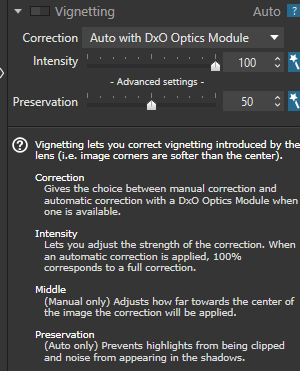Why would anyone want to enable a camera function that permanently changes a raw file? It’s a personal choice but I would never want my raw files to be permanently impacted by this “feature” which seems designed for jpg’s.
Note: Adobe raw converters only apply the lens corrections that are embedded in the raw file which directly match the in camera jpg. If you want to limit your raws to be equivalent of jpg’s it’s a personal choice but not one I would make.
i turned it off at this moment and let it “on”/active at a custom EZ function (jpeg only)
Longshutter noise reduction : active. (raw altering) (red noise reduction)
Diffractioncompensation “auto” (also raw altering?)
I would be interested in some insight about if the other two has effect or not in DxO’s optical module.
in a good or bad way.
yes i agree, a warning would be helpful. (at first in the manual of my camera!)
But if DxO can read the exif to pop up this warning if needed that would also be great.
In-camera diffraction compensation does not affect the RAW image. It applies rather effective deconvolution sharpening to the camera’s JPEG image when shooting at small apertures. I rarely shoot at apertures that would benefit from it, but did test it a few years ago against DxO’s RAW lens sharpening. I remember being very impressed with both but liking DxO’s result better.
Adobe RAW works correctly because it does not correct vignetting as the embedded lens profile does not contain vignetting corrections.
Photolab does not because it ignores the exif flag and makes assumptions that in most cases are correct but not in this case
What is everyone choice is not for anybody else to question. If you shoot RAW and JPEG in fact you may want to leave the setting on, it does not correct vignetting 100% and is very effective
My suggestion is similar to others. Disable in body shading and do all correction post production. Manually or with a recipe if no optics module exists. These are (I believe) necessary concessions you make when your use case doesn’t fit a typical scenario.

Thanks for your suggestion but I have hundreds of images already with the setting on. So I would like my software to recognise that and work properly which is what adobe camera raw does
The Olympus Menu setting to add vignetting control (shading compensation) does affect RAWS. I have proven this, as have others, and once the RAW has the data embedded, it can not be undone (by any method I am aware of). It is a rather crude vignetting solution and can sometimes be seen as banding… several rings visible from centre outwards, in areas of a photo that are underexposed and of uniform brightness.
DXO would have to find a way of stripping the Shading Compensation data out of a RAW EXIF and advising this is their default handling method, or advise users that there is either a choice, or that nothing can be done and they should switch off the in camera setting.
It is an important issue brought up by “interceptor121” as vignetting control, done badly, can ruin a lens character. The Panaleica 42.5mm f1.2 has a beautiful vignetting character that creates a focus on the subject and enhances the image in most cases. I sometimes add a custom vignetting control when processing RAW to produce some correction, but starting out with “corrected” RAW from the in camera correction, creates a mess dealing with it.
DXO has the best lens profiles in the business, and needs to address this. Their vignetting control feature is superb but is ruined by the Olympus in camera correction.
Also in the panasonics.
It’s corrected before stored in rw2.
Ireversable i am afraid.
Best option is turn in camera correction off.
Spot on
In my view the following are required
- Disable Vignetting correction from default DxO correction. Most lenses end up with far too bright frame and the image does not gain anything
- Detect if shading compensation was already applied and in that case grey out the DxO correction or issue a warning.
Although I agree that the setting can create banding there are situations where you use the camera for video and it works OK and you may then leave it set. So detecting the setting is appropriate as well as not correcting automatically